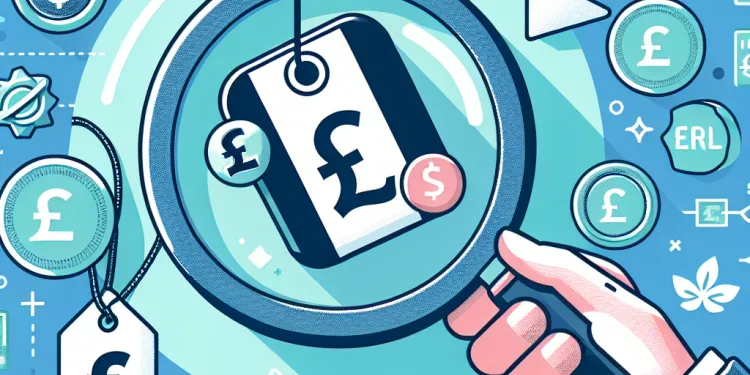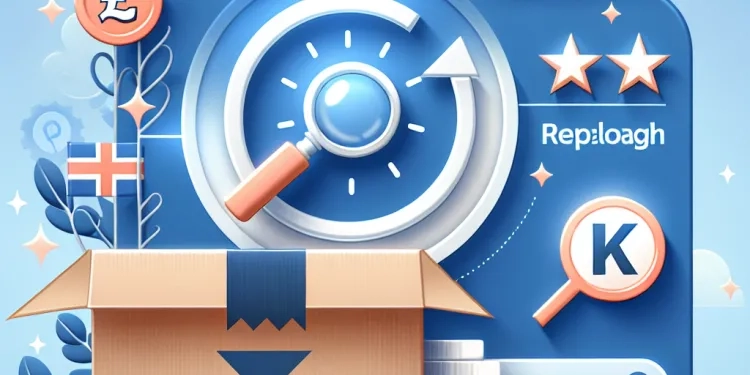
Find Help
More Items From Ergsy search
-

What should businesses do if they discover a product defect?
Relevance: 100%
-

How are product recalls managed in the UK?
Relevance: 55%
-

What is a Product Recall in the UK?
Relevance: 52%
-

Are there any penalties for not complying with a product recall?
Relevance: 49%
-

What are common reasons for product recalls?
Relevance: 45%
-

Can product recalls be reversed?
Relevance: 42%
-

Can recalled products be resold?
Relevance: 42%
-

Who can initiate a product recall in the UK?
Relevance: 42%
-

Will the Trump Tariffs affect my business?
Relevance: 39%
-

Does the sugar tax apply to small businesses?
Relevance: 37%
-

How are consumers informed about a product recall?
Relevance: 36%
-

Can a product recall be voluntary?
Relevance: 36%
-

What is the role of the Office for Product Safety and Standards in a recall?
Relevance: 34%
-

Can businesses claim the EV grant?
Relevance: 33%
-

UK Businesses Struggle with Supply Chain Delays Impacting Profits
Relevance: 32%
-

How long does a product recall usually last?
Relevance: 32%
-

What are the potential consequences for a company that fails to recall a dangerous product?
Relevance: 31%
-

Can businesses be charged Stamp Duty?
Relevance: 31%
-

Are there grants for businesses to install charging points?
Relevance: 31%
-

Which regulatory authority oversees product recalls in the UK?
Relevance: 31%
-

Can businesses be exempt from hosepipe bans?
Relevance: 30%
-

What types of products can be recalled?
Relevance: 30%
-

Is the HMRC Employer Bulletin relevant for small businesses?
Relevance: 30%
-

Can businesses apply for the Plug-in Car Grant?
Relevance: 29%
-

Exercise Routines for Busy Parents
Relevance: 29%
-

Can businesses get grants for electric vehicles?
Relevance: 29%
-

How often do product recalls occur?
Relevance: 27%
-

Blood Product Transfusions
Relevance: 27%
-

What is the difference between a product recall and a safety notice?
Relevance: 26%
-

What types of blood products can be transfused?
Relevance: 26%
-

What should business owners expect from income tax changes in 2026?
Relevance: 26%
-

What should I look for when buying CBD products?
Relevance: 26%
-

Product Transfer Rate Switch vs Remortgage What's Best
Relevance: 25%
-

Are all car finance products potentially subject to mis-selling?
Relevance: 24%
-

Are caffeine pouches a tobacco product?
Relevance: 23%
-

What should I do if a product I own is recalled?
Relevance: 22%
-

What steps can a company take if shareholder disputes begin to impact business operations?
Relevance: 21%
-

What is a product recall?
Relevance: 20%
-

What role do consumers play in the recall process?
Relevance: 20%
-

Can businesses participate in the Postcode Lottery?
Relevance: 19%
Understand the Scope and Impact of the Defect
When a business in the UK discovers a product defect, the first step is to assess the scope and impact of the defect. This involves determining how widespread the defect is among the products and understanding the potential risks or harms it may pose to customers. Gathering detailed information about the nature of the defect, including how it was identified and any reported incidents from consumers, is crucial for an effective response.
Inform the Relevant Authorities and Stakeholders
In the UK, businesses are required to inform relevant authorities such as Trading Standards and potentially the Office for Product Safety and Standards (OPSS) if the product defect poses any risk to consumers. This ensures that the regulatory bodies are aware of potential safety issues. Additionally, informing stakeholders within the company, including legal, communications, and operations teams, is essential for coordinating an effective response.
Implement a Product Recall or Safety Notification
If the defect poses a risk to consumer safety, businesses must swiftly implement a product recall or issue a safety notification to prevent harm. This includes communicating directly with consumers through various channels such as emails, social media, and press releases to advise them on how to identify and return the defective products. In some cases, businesses may offer refunds, repairs, or replacements as part of the recall strategy.
Evaluate and Improve Quality Control Processes
After addressing the immediate concerns of a product defect, businesses should evaluate their existing quality control processes to prevent future occurrences. This includes investigating the root cause of the defect, whether it was a manufacturing error, design flaw, or supply chain issue. Based on the findings, businesses should implement improved quality assurance practices and consider retraining staff to maintain high standards.
Maintain Open Communication with Customers
Maintaining open and honest communication with customers is vital for preserving trust and brand reputation. Businesses should provide regular updates to consumers affected by the defect, ensuring they are informed about the steps being taken to resolve the issue. This transparency can bolster consumer confidence in the company's commitment to safety and quality.
Review Legal Obligations and Potential Liabilities
Businesses must be aware of legal obligations regarding product liability and consumer protection in the UK. Consulting with legal experts to understand potential liabilities and ensuring compliance with the Consumer Rights Act 2015 is important. In certain cases, businesses might face legal claims from affected customers, so preparing a robust legal strategy is advisable.
Find Out How Big the Problem Is
If a product is not working right, businesses need to see how big the problem is. They should find out how many products have the mistake and if it is dangerous for people. It is important to get all the details about the problem, like how it was found and if anyone got hurt.
Tell the Right People
In the UK, businesses must tell the authorities like Trading Standards if there is a problem with a product. This is to keep people safe. They should also tell everyone in the company who needs to know, like the legal team, to help fix the problem.
Recall Dangerous Products
If the product can hurt people, the business should stop selling it and tell people to send it back. They can do this by sending emails or using social media. Businesses might also give money back, fix the product, or give a new one instead.
Make Products Better in the Future
After fixing the problem, businesses should look at how they check products. They need to find out why the mistake happened and make sure it does not happen again. This might mean training workers better.
Talk to Customers
It is important for businesses to talk to their customers about the problem. They should tell them what they are doing to fix it. Keeping customers updated helps them trust the business.
Understand the Laws
Businesses need to know the rules about products and customer rights in the UK. They might need help from legal experts to make sure they are following the law. If customers complain, it is good to be ready with a plan.
Frequently Asked Questions
What is the first step a business should take if it discovers a product defect?
The first step is to stop selling the product and investigate the defect to understand its cause and potential impact.
Should a business notify customers immediately after discovering a defect?
Yes, if the defect poses a safety risk, customers should be notified as soon as possible to prevent harm.
How should a business handle a product recall?
Develop a clear recall plan, communicate effectively with customers, and follow regulatory guidelines to collect the defective products.
What role does quality assurance play in addressing product defects?
Quality assurance can help identify the root cause of the defect and implement corrective measures to prevent future occurrences.
Should a business involve legal counsel when dealing with a product defect?
Yes, involving legal counsel is crucial to navigate liability issues, regulatory compliance, and potential litigation.
What are the potential consequences of not addressing a product defect?
Ignoring a defect can lead to legal action, damage to the brand's reputation, and potential harm to consumers.
How important is documentation in the defect resolution process?
Documentation is essential to track the investigation process, communication, and corrective actions taken.
What external parties should a business notify about a product defect?
Regulatory bodies, consumers, distributors, and retailers should be notified as required by relevant regulations.
How can a business determine the scope and scale of the defect?
Conduct a thorough investigation and trace the product's supply chain to identify all affected units.
Is product insurance helpful in defect scenarios?
Yes, product liability insurance can help cover the costs associated with recalls, litigation, and compensation.
What should a business do if the defect was caused by a supplier's component?
Communicate with the supplier to address the issue and potentially seek compensation or reimbursement.
What corrective actions might a business take after discovering a product defect?
Enhancing quality control, redesigning the product, retraining staff, and improving supplier management are potential corrective actions.
Why is it important to maintain customer trust during a product defect situation?
Maintaining trust can help preserve the company's reputation and customer loyalty despite the defect.
Can product defects lead to product liability lawsuits?
Yes, if the defect causes harm to consumers, the business might face legal action from affected parties.
How can communication strategies mitigate the impact of a product defect?
Clear, honest, and timely communication can help manage consumer expectations and reduce reputational damage.
What should a company do if the defect is found in a widely distributed product?
Prioritize public safety by initiating a recall and use all available channels to notify distributors and consumers quickly.
How can a business learn from a product defect incident?
Conduct a post-mortem analysis to identify weaknesses in processes and implement improvements to prevent future defects.
What internal changes might be necessary after resolving a product defect?
Revise internal policies, enhance staff training, and possibly restructure teams to ensure better quality control.
Should a business offer compensation to customers affected by a defect?
Offering compensation, such as refunds, replacements, or vouchers, can help retain customer goodwill and loyalty.
How does regulatory compliance play a role in addressing product defects?
Compliance with regulations is crucial to avoid penalties and ensure that safety standards are consistently met.
What should a business do first if they find a problem with a product?
Here's what to do:
1. Stop selling the product right away. This keeps people safe.
2. Tell the customers about the problem. It's important they know.
3. Fix the problem before selling it again.
If you need help reading, try using simple words or ask someone you trust.
First, stop selling the product. Find out why it's broken and how it might hurt people.
Should a business tell customers right away if something is wrong?
Customers need to know if there is a problem. It's good to tell them quickly. This helps keep customers safe and happy. If there is a mistake or issue, say it as soon as you find out.
Helpful Tip: Use simple words when you talk to customers. You can also use pictures and videos to help explain.
Yes, if something is broken and could be dangerous, customers should be told quickly to keep them safe.
What should a business do when it needs to take back a product?
When a business has to take a product back, it should:
- Tell customers quickly. Use letters, emails, or the website.
- Say why the product is not good or safe.
- Give customers clear steps to return or fix the product.
- Make sure they know how to get help and where to ask questions.
- Check that the problem will not happen again.
Helpful tools or techniques:
- Use simple words and short sentences.
- Add pictures or videos to show what to do.
- Offer a phone number to call for help.
Make a simple plan to get back broken products. Talk clearly to customers. Follow the rules when collecting the broken things.
Here are some ways to help:
- Use short, clear words.
- Ask friends or family if you need help.
- Use pictures or drawings to understand better.
How does checking quality help fix product problems?
Quality assurance means checking products to make sure they are good. It helps find and fix problems with products before they reach people. This makes sure that people get products that work well.
Support tools:
- Checklists to see if the product is working well.
- Simple flow charts to show each step in checking products.
- Pictures or videos to help understand how to check products.
Quality checks can find out why a problem happened. Then, we can fix it so it doesn't happen again.
Should a Business Talk to a Lawyer About a Problem with a Product?
If there is something wrong with a product a business makes or sells, it might be a good idea to talk to a lawyer. Here are some simple questions to help decide:
- Is the problem with the product serious?
- Could the problem hurt someone?
- Are people asking for money back because of the problem?
Talking to a lawyer can help find the best solution. A lawyer can also help the business understand what to do next.
If you need help to read or understand, you can ask someone to read it with you or use a reading tool or app.
Yes, it is important to have a lawyer help if there are any legal problems or risks.
What can happen if a problem with a product is not fixed?
If a product has a problem and it is not fixed, here is what can happen:
- The product might break or not work properly.
- People who use the product might get hurt.
- Customers might be unhappy and not want to buy from the company again.
- The company might get into trouble and have to pay money or go to court.
Tools to help you understand:
- Use a dictionary to learn new words.
- Ask someone to explain any parts you don't understand.
If you don't fix a problem with a product, it can cause three big issues:
1. Someone might take you to court.
2. People might think badly about your brand.
3. The product might hurt someone.
It's important to fix problems quickly and use tools like lists or reminders to keep track.
Why is writing things down important when fixing problems?
Writing things down is very important. It helps us remember what we found out, who we talked to, and what we did to fix problems.
Who should a business tell about a problem with a product?
If a product has a problem, the business should tell some people. Here are some people to tell:
- Customers: People who bought or use the product.
- Suppliers: People who make or send parts for the product.
- Regulators: People who make rules to keep things safe.
- Partners: Other businesses that work with your business.
To help you understand better, you can:
- Use pictures to show who to tell.
- Write down each person to tell, in simple words.
We need to let certain people know important information. These people include rule-makers, customers, people who sell things, and shops. This is because there are rules about when we must tell them things.
How can a business find out how big a problem is?
Businesses need to find out how big a problem is. To do this, they can:
- Look at customer feedback. What are people saying?
- Count how many products have the problem.
- Check how bad the problem is. Does it stop the product from working?
- Talk to staff. What do they think?
Tools that can help:
- Use surveys to ask customers questions.
- Make a checklist to see where problems are happening.
By doing these things, businesses can understand how big the problem is and how it affects them.
Look carefully at where the product comes from and goes to. Find all the products that might have a problem.
Does having insurance help if a product breaks?
Yes, product liability insurance can help pay for costs if something goes wrong. It helps with recalls, court cases, and paying people back.
What should a business do if a part from a supplier is faulty?
Businesses can follow these steps:
1. Talk to the Supplier: Call or write to the supplier to tell them about the problem. Use clear words.
2. Keep Records: Write down what happened and keep all emails or letters. This helps to have proof.
3. Check the Agreement: Look at the deal you made with the supplier. See what they said they would do if something went wrong.
4. Replace or Fix: Ask the supplier to give a new part or fix the faulty one.
5. Ask for Help: If you need extra help, ask a trade association or legal advisor.
Reading Tools:
- Text-to-speech apps can read out loud.
- Use picture dictionaries to help understand words.
Talk to the supplier. Tell them about the problem. You can ask for money back or something to make up for it.
What can a business do if a product has a mistake?
Here are some things a business can do if a product has a mistake:
- Fix the product to make it right.
- Tell customers about the mistake.
- Give customers their money back or a new product.
- Make sure the mistake doesn’t happen again.
To help, businesses can:
- Use clear checklists when making products.
- Train workers to spot mistakes.
We can do some things to make our products better. These include:
- Make sure the products are good quality.
- Change the way we make the product.
- Teach our staff again how to do their jobs well.
- Work better with the people who give us our materials.
These steps will help us a lot.
Why is it important to keep customers' trust when a product is broken?
When something you sell has a problem, it is important to keep your customers' trust. This is because:
- If customers trust you, they are more likely to buy from you again.
- Trust helps people feel safe and happy with your brand.
- Trust means customers know you will help them if there is a problem.
Here are some ways to keep trust:
- Say sorry if something goes wrong.
- Fix the problem quickly.
- Tell customers what you are doing to make things better.
Tools that help:
- Customer service: Be ready to answer their questions.
- Feedback: Listen to what customers say and learn from it.
Keeping trust helps the company stay respected and keeps customers coming back, even if there is a problem.
Can problems with a product cause legal trouble?
If the product is broken and someone gets hurt, the business might have to go to court.
How can talking and sharing ideas help with a product problem?
If there is a problem with a product, talking and sharing information can help. Here are some steps to make things better:
1. Tell people what happened: Explain the problem clearly so everyone understands.
2. Say sorry: Apologize for the trouble the product caused.
3. Offer help: Let people know how you will fix the problem or give them something that helps.
4. Keep in touch: Update everyone about what is being done to make things right.
Use helpers: Draw pictures or use simple charts to show what's happening. This can make it easier to understand.
It is important to talk clearly and honestly. This helps people understand what to expect and can stop problems with your reputation.
What should a company do if there is a problem with a product lots of people have?
Here is what a company can do if they find a problem with a product many people have:
- Tell everyone about the problem.
- Stop selling the product right away.
- Fix the problem or change the product.
- Help customers return the product if needed.
- Make sure the problem does not happen again.
Using simple words and pictures can help everyone understand. Also, reading out loud or using audio tools can be useful.
Make sure people are safe first. Start by taking the product back. Use every way you can to tell stores and people about it fast.
What can a business learn from a product problem?
Here are some simple steps:
- See what went wrong: Look at the problem closely. Find out why the product had an issue.
- Talk to your team: Have a meeting with your team. Share what you found out.
- Ask the customers: Talk to the people who used the product. Ask them what they think.
- Fix the problem: Work on a way to stop the problem from happening again. Make a plan.
- Learn from mistakes: Understand how to do better next time.
Some tools to help:
- Use pictures and diagrams to explain things clearly.
- Write down important points in simple words.
- Work with others to solve the problem quicker.
After something goes wrong, look at what happened closely to find out what didn't work well. Then, make things better so the same mistakes don't happen again.
What changes inside a company are needed after fixing a problem with a product?
When a product has a problem, it is important to fix it. After fixing it, the company might need to make changes inside. These changes help stop the problem from happening again.
Here are some possible changes:
- Improve the way products are made.
- Train workers on how to check products better.
- Talk more with everyone who helps make the product.
- Use better tools to find problems early.
A good way to remember these changes is to:
- Fix the product first.
- Learn from what went wrong.
- Make the inside changes to stop future problems.
Change rules at work, help staff learn better, and maybe make new teams to do better work.
Should a business give something back to unhappy customers?
If a product is broken or doesn't work, a business might give the customer money back or a free gift.
This is called "compensation." It helps make customers happy again.
Tools like picture cards or simple apps can help understand this better.
Giving things like money back, new items, or gift cards can make customers happy and keep them coming back.
How do rules help fix problems with products?
Rules can help make sure products are safe. They tell companies what to do if something goes wrong.
If a product has a problem, rules say how to fix it. This can help keep people safe.
Using pictures or videos can make understanding easier. Talking to someone about rules can also help.
It is very important to follow the rules. This helps us stay safe and avoid getting into trouble.
Useful Links
- Ergsy carfully checks the information in the videos we provide here.
- Videos shown by Youtube after a video has completed, have NOT been reviewed by ERGSY.
- To view, click the arrow in centre of video.
- Most of the videos you find here will have subtitles and/or closed captions available.
- You may need to turn these on, and choose your preferred language.
- Go to the video you'd like to watch.
- If closed captions (CC) are available, settings will be visible on the bottom right of the video player.
- To turn on Captions, click settings .
- To turn off Captions, click settings again.
More Items From Ergsy search
-

What should businesses do if they discover a product defect?
Relevance: 100%
-

How are product recalls managed in the UK?
Relevance: 55%
-

What is a Product Recall in the UK?
Relevance: 52%
-

Are there any penalties for not complying with a product recall?
Relevance: 49%
-

What are common reasons for product recalls?
Relevance: 45%
-

Can product recalls be reversed?
Relevance: 42%
-

Can recalled products be resold?
Relevance: 42%
-

Who can initiate a product recall in the UK?
Relevance: 42%
-

Will the Trump Tariffs affect my business?
Relevance: 39%
-

Does the sugar tax apply to small businesses?
Relevance: 37%
-

How are consumers informed about a product recall?
Relevance: 36%
-

Can a product recall be voluntary?
Relevance: 36%
-

What is the role of the Office for Product Safety and Standards in a recall?
Relevance: 34%
-

Can businesses claim the EV grant?
Relevance: 33%
-

UK Businesses Struggle with Supply Chain Delays Impacting Profits
Relevance: 32%
-

How long does a product recall usually last?
Relevance: 32%
-

What are the potential consequences for a company that fails to recall a dangerous product?
Relevance: 31%
-

Can businesses be charged Stamp Duty?
Relevance: 31%
-

Are there grants for businesses to install charging points?
Relevance: 31%
-

Which regulatory authority oversees product recalls in the UK?
Relevance: 31%
-

Can businesses be exempt from hosepipe bans?
Relevance: 30%
-

What types of products can be recalled?
Relevance: 30%
-

Is the HMRC Employer Bulletin relevant for small businesses?
Relevance: 30%
-

Can businesses apply for the Plug-in Car Grant?
Relevance: 29%
-

Exercise Routines for Busy Parents
Relevance: 29%
-

Can businesses get grants for electric vehicles?
Relevance: 29%
-

How often do product recalls occur?
Relevance: 27%
-

Blood Product Transfusions
Relevance: 27%
-

What is the difference between a product recall and a safety notice?
Relevance: 26%
-

What types of blood products can be transfused?
Relevance: 26%
-

What should business owners expect from income tax changes in 2026?
Relevance: 26%
-

What should I look for when buying CBD products?
Relevance: 26%
-

Product Transfer Rate Switch vs Remortgage What's Best
Relevance: 25%
-

Are all car finance products potentially subject to mis-selling?
Relevance: 24%
-

Are caffeine pouches a tobacco product?
Relevance: 23%
-

What should I do if a product I own is recalled?
Relevance: 22%
-

What steps can a company take if shareholder disputes begin to impact business operations?
Relevance: 21%
-

What is a product recall?
Relevance: 20%
-

What role do consumers play in the recall process?
Relevance: 20%
-

Can businesses participate in the Postcode Lottery?
Relevance: 19%


